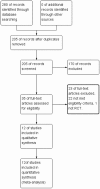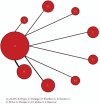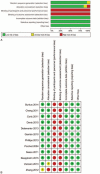Durability of cervical disc arthroplasties and its influence factors: A systematic review and a network meta-analysis
- PMID: 28178135
- PMCID: PMC5312992
- DOI: 10.1097/MD.0000000000005947
Durability of cervical disc arthroplasties and its influence factors: A systematic review and a network meta-analysis
Abstract
Background: The durability of cervical disc arthroplasties (CDA) may vary significantly because of different designs and implanting techniques of the devices. Nevertheless, the comparative durability remains unknown.
Objectives: We aimed to assess the durability of CDAs in at least 2-year follow-up. We analyzed the classifications and causes of secondary surgical procedures, as well as the structural designs of the devices that might influence the durability.
Methods: PubMed, Medline, Embase, and Cochrane Central Register of Controlled Trials were searched from the inception of each database to September 2015 using the following Keywords: "cervical disc replacement" OR "cervical disc arthroplasty" AND "randomized controlled trial (RCT)." Publication language was restricted to English. The primary outcome was the rate of secondary surgical procedures following CDA or anterior cervical decompression and fusion (ACDF). Pairwise meta-analysis and a Bayesian network meta-analysis were carried out using Review Manager v5.3.5 and WinBUGS version 1.4.3, respectively. Quality of evidence was appraised by Grading of Recommendations Assessment, Development and Evaluation methodology.
Results: Twelve RCTs that met the eligibility criteria were included. Follow-up ranged from 2 years to 7 years. A total of 103 secondary surgical procedures were performed. The most frequent classification of secondary surgical procedures was reoperation (48/103) and removal (47/103). Revision (3/103) and supplementary fixation (2/103) were rare. Adjacent-level diseases were the most common cause of reoperations. The rates of secondary surgical procedures were significantly lower in Mobi-C, Prestige, Prodisc-C, Secure-C group than in ACDF group. No significant difference was detected between Bryan, PCM, Kineflex-C, Discover, and ACDF. Mobi-C, Secure-C, and Prodisc-C ranked the best, the second best, the third best, respectively.
Conclusions: We concluded that Mobi-C, Secure-C, and Prodisc-C were more durable than ACDF. Precise selection of device size and proper surgical techniques are implicated to be crucial to enhance the perdurability. Device design should concentrate on the imitation of biomechanics of normal cervical disc, and semi-constrained structural device is a better design to make CDA more durable.
Conflict of interest statement
Each author certifies that he has no commercial associations that might pose a conflict of interest in connection with the submitted article.
Figures






Similar articles
-
Arthroplasty versus fusion in single-level cervical degenerative disc disease.Cochrane Database Syst Rev. 2012 Sep 12;(9):CD009173. doi: 10.1002/14651858.CD009173.pub2. Cochrane Database Syst Rev. 2012. Update in: Cochrane Database Syst Rev. 2015 May 21;(5):CD009173. doi: 10.1002/14651858.CD009173.pub3. PMID: 22972137 Updated.
-
Effect of device constraint: a comparative network meta-analysis of ACDF and cervical disc arthroplasty.Spine J. 2024 Oct;24(10):1858-1871. doi: 10.1016/j.spinee.2024.05.016. Epub 2024 Jun 4. Spine J. 2024. PMID: 38843960
-
Medical and surgical interventions for the treatment of usual-type vulval intraepithelial neoplasia.Cochrane Database Syst Rev. 2016 Jan 5;2016(1):CD011837. doi: 10.1002/14651858.CD011837.pub2. Cochrane Database Syst Rev. 2016. PMID: 26728940 Free PMC article.
-
Kinematics of the cervical adjacent segments after disc arthroplasty compared with anterior discectomy and fusion: a systematic review and meta-analysis.Spine (Phila Pa 1976). 2012 Oct 15;37(22 Suppl):S85-95. doi: 10.1097/BRS.0b013e31826d6628. Spine (Phila Pa 1976). 2012. PMID: 22885834
-
Drugs for preventing postoperative nausea and vomiting in adults after general anaesthesia: a network meta-analysis.Cochrane Database Syst Rev. 2020 Oct 19;10(10):CD012859. doi: 10.1002/14651858.CD012859.pub2. Cochrane Database Syst Rev. 2020. PMID: 33075160 Free PMC article.
Cited by
-
On evidence cycles in network meta-analysis.Stat Interface. 2020;13(4):425-436. doi: 10.4310/sii.2020.v13.n4.a1. Stat Interface. 2020. PMID: 32742550 Free PMC article.
-
Treatment of failed cervical total disc replacements in a series of 53 cases and description of a management strategy.Eur Spine J. 2024 Aug;33(8):3117-3123. doi: 10.1007/s00586-024-08402-7. Epub 2024 Jul 18. Eur Spine J. 2024. PMID: 39026079
-
Optimization of a bearing geometry for a cervical total disc replacement.Front Bioeng Biotechnol. 2025 Apr 8;13:1469366. doi: 10.3389/fbioe.2025.1469366. eCollection 2025. Front Bioeng Biotechnol. 2025. PMID: 40264917 Free PMC article.
-
Effectiveness of percutaneous neuromuscular electrical stimulation for neck pain relief in patients with cervical spondylosis.Medicine (Baltimore). 2018 Jun;97(26):e11080. doi: 10.1097/MD.0000000000011080. Medicine (Baltimore). 2018. PMID: 29952946 Free PMC article. Clinical Trial.
-
Safety and efficacy of cervical disc arthroplasty in preventing the adjacent segment disease: a meta-analysis of mid- to long-term outcomes in prospective, randomized, controlled multicenter studies.Ther Clin Risk Manag. 2019 Mar 28;15:531-539. doi: 10.2147/TCRM.S196349. eCollection 2019. Ther Clin Risk Manag. 2019. PMID: 30992666 Free PMC article. Review.
References
-
- Davis RJ, Kim KD, Hisey MS, et al. Cervical total disc replacement with the Mobi-C cervical artificial disc compared with anterior discectomy and fusion for treatment of 2-level symptomatic degenerative disc disease: a prospective, randomized, controlled multicenter clinical trial: clinical article. J Neurosurg Spine 2013;19:532–45. - PubMed
-
- Hacker FM, Babcock RM, Hacker RJ. Very late complications of cervical arthroplasty: results of 2 controlled randomized prospective studies from a single investigator site. Spine (Phila Pa 1976) 2013;38:2223–6. - PubMed
-
- Jawahar A, Cavanaugh DA, Kerr EJ, 3rd, et al. Total disc arthroplasty does not affect the incidence of adjacent segment degeneration in cervical spine: results of 93 patients in three prospective randomized clinical trials. Spine J 2010;10:1043–8. - PubMed
-
- Zigler JE, Delamarter R, Murrey D, et al. ProDisc-C and anterior cervical discectomy and fusion as surgical treatment for single-level cervical symptomatic degenerative disc disease: five-year results of a Food and Drug Administration study. Spine (Phila Pa 1976) 2013;38:203–9. - PubMed
-
- Sasso RC, Smucker JD, Hacker RJ, et al. Clinical outcomes of BRYAN cervical disc arthroplasty: a prospective, randomized, controlled, multicenter trial with 24-month follow-up. J Spinal Disord Tech 2007;20:481–91. - PubMed
Publication types
MeSH terms
LinkOut - more resources
Full Text Sources
Other Literature Sources
Medical
Miscellaneous

